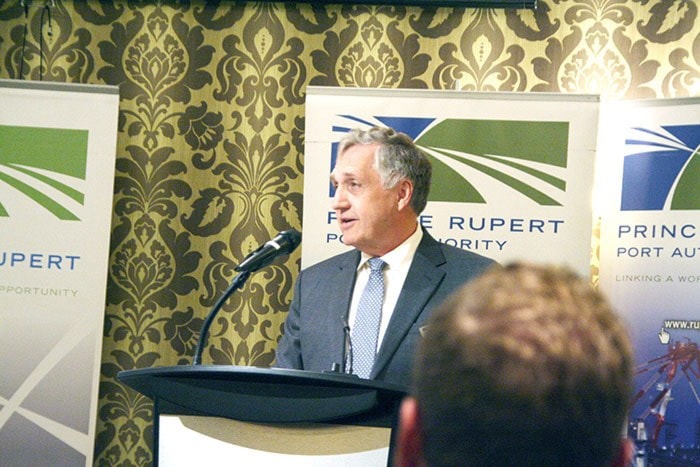Despite lower overall tonnage traffic moving through the Port of Prince Rupert in 2014, a decrease largely due to its decline in coal traffic, the year was a record-breaking one for the Prince Rupert Port Authority (PRPA).
20.7 million tonnes were processed by the port’s terminal operators in 2014 - a 2.2 million tonne drop in traffic or a 10 per cent decrease from 2013. It was a main highlight during the Prince Rupert Port Authority’s Annual Public Meeting last Thursday at the Crest Hotel’s British Columbia room.
Ridley Terminals Inc. experienced the largest decrease in volume with a nearly five million tonne drop in coal, or a 41 per cent decrease, totalling 7.1 million tonnes on the year.
Conversely, record-setting numbers were posted by Prince Rupert Grain. The terminal handled 6.5 million tonnes, which is a 26 per cent increase over 2013 and containerized cargo volumes posted a total annual increase of 15 per cent, as the port handled 618,000 TEUs through Fairview Container Terminal, helped significantly by import traffic, up nearly 20 per cent.
“That five million tonne drop in 2014 of coal was offset by some pretty spectacular results in other areas,” said PRPA president and CEO Don Krusel on Thursday.
“The dynamic weakness that we experience in one area of our overall operations, i.e. coal, has been able to be overcome by progress and successes in other areas and that’s a sign of a maturing port, it’s a sign of a diversified port and that’s what we have been striving for ... [It’s] a way that we aren’t reliant on just one sector of the gateway economy and I think 2014 is a good illustration of how the diversification can support that dynamic port gateway and represents another example of how this gateway is maturing.”
In addition to the increased volumes within Prince Rupert Grain Terminal and Fairview Container Terminal, PRPA shipped 500,000 tonnes of biofuel during its first year of operations at Westview Wood Pellet Terminal.
The port’s net income figures increased from approximately $16.5 million to $26.3 million (59 per cent), total assets spiked from approximately $133.5 to $186 million and capital expenditures rose as well.
“The port’s importance to the trade flow and economy of British Columbia and Canada should not be underestimated. Canadian exports flowing through our port now value over $5 billion annually,” said Port of Prince Rupert board of directors chair, Bud Smith.
The port also gained notoriety earlier this year when the Journal of Commerce named Fairview Terminal the fastest growing container port in North America. The completion of the Road, Rail and Utility Corridor and the more recent 2015 worldwide record for largest biofuel or wood pellet shipment in the history of the sector also highlighted the meeting.
While Ridley Terminals (RTI) experiences the downturn in coal handling numbers, vice president of trade development and public affairs, Shaun Stevenson, noted that the port isn’t just sitting back in regards to maximizing the terminal’s efficiency.
“We saw Ridley Terminals complete their expansion to 18 million tonnes in capacity which positions that terminal and the Port of Prince Rupert well when we see a return to strong demand for metallurgical coal ... in addition, we’re working with RTI to explore areas of diversification for that terminal to see if there’s opportunities to diversify the capabilities of that dry bulk terminal on the near term that might preserve the activity there,” said Stevenson.
As well, the port has been engaged with Canpotex, a potash exporter to potentially develop a potash terminal within the next few years, pending a final investment decision by Canpotex.
“[We’ve entered a] long-term lease. They’re committed to making a final investment decision (FID) within the next two years and the only thing preventing that FID between [now and later] is ... internationally potash prices have been in decline ... They’re just waiting for the right investment climate and when the markets return, and anybody that follows potash knows that it’s an agricultural input to the agricultural industry, they expect that will return and it will always be needed and it’s just a matter of when’s the right time,” Krusel said.
“Within our lease there is a deadline requirement for them to make a FID [ending in the next couple years],” said Stevenson.
Also, the port’s community investment fund’s total contributions were boosted to $4.3 million total [since 2010] after a $1.5 million increase in 2014.
